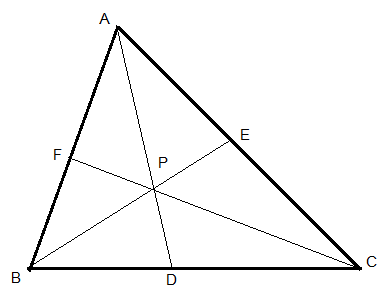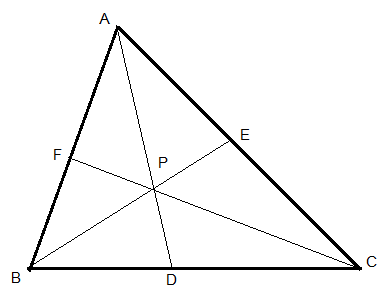
Find the missing side for the Ceva’s theorem, \[\dfrac{{AF}}{{FB}} \cdot \dfrac{{BD}}{{DC}} \cdot \dfrac{{CE}}{X} = 1\]. Find X.


Answer
573.9k+ views
Hint: Ceva’s theorem states that if three lines are drawn in a triangle from each vertex to opposite sides, then the sides are divided equally or the lines will act as the bisector for the other side. Moreover, all the three lines intersect in a single point if the sides are divided into parts.
In this question, we need to determine the side from the given triangle which will replace the value of x. Moreover, it has already been mentioned in the question to use Ceva's theorem only.
Complete step by step solution:
According to Ceva’s theorem three lines are drawn in a triangle from each vertex to opposite i.e. from vertex A line AD is drawn on BC, from vertex B line BE is drawn on AC and from vertex C line CF is drawn on AB. So by the statement of Ceva’s theorem, these sides are divided into parts.
.

As we can see that the point D divides the line BC; point F divides the line AB so, following Ceva's theorem, we can say that the point E will certainly divide the line AC. So,
\[\dfrac{{AF}}{{FB}} \cdot \dfrac{{BD}}{{DC}} \cdot \dfrac{{CE}}{X} = 1\]
Hence, X = EA
By statement of Ceva’s theorem, we can say that: \[\dfrac{{AF}}{{FB}} \cdot \dfrac{{BD}}{{DC}} \cdot \dfrac{{CE}}{{EA}} = 1\]
Note: For doing this question, students must have some knowledge of Ceva’s theorem so that they will be able to solve this. Moreover, students should be aware while using the sides in the numerator and the denominator.
In this question, we need to determine the side from the given triangle which will replace the value of x. Moreover, it has already been mentioned in the question to use Ceva's theorem only.
Complete step by step solution:
According to Ceva’s theorem three lines are drawn in a triangle from each vertex to opposite i.e. from vertex A line AD is drawn on BC, from vertex B line BE is drawn on AC and from vertex C line CF is drawn on AB. So by the statement of Ceva’s theorem, these sides are divided into parts.
.

As we can see that the point D divides the line BC; point F divides the line AB so, following Ceva's theorem, we can say that the point E will certainly divide the line AC. So,
\[\dfrac{{AF}}{{FB}} \cdot \dfrac{{BD}}{{DC}} \cdot \dfrac{{CE}}{X} = 1\]
Hence, X = EA
By statement of Ceva’s theorem, we can say that: \[\dfrac{{AF}}{{FB}} \cdot \dfrac{{BD}}{{DC}} \cdot \dfrac{{CE}}{{EA}} = 1\]
Note: For doing this question, students must have some knowledge of Ceva’s theorem so that they will be able to solve this. Moreover, students should be aware while using the sides in the numerator and the denominator.
Recently Updated Pages
Two men on either side of the cliff 90m height observe class 10 maths CBSE

What happens to glucose which enters nephron along class 10 biology CBSE

Cutting of the Chinese melon means A The business and class 10 social science CBSE

Write a dialogue with at least ten utterances between class 10 english CBSE

Show an aquatic food chain using the following organisms class 10 biology CBSE

A circle is inscribed in an equilateral triangle and class 10 maths CBSE

Trending doubts
Why is there a time difference of about 5 hours between class 10 social science CBSE

Write a letter to the principal requesting him to grant class 10 english CBSE

What is the median of the first 10 natural numbers class 10 maths CBSE

The Equation xxx + 2 is Satisfied when x is Equal to Class 10 Maths

Which of the following does not have a fundamental class 10 physics CBSE

State and prove converse of BPT Basic Proportionality class 10 maths CBSE




